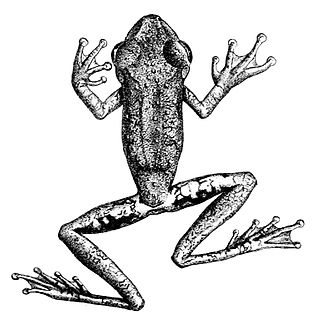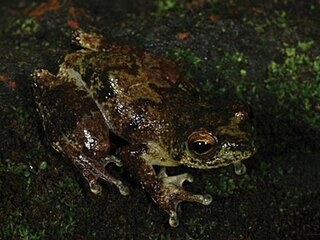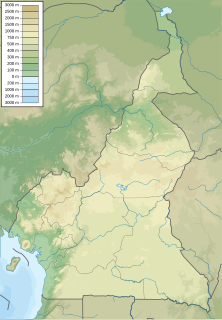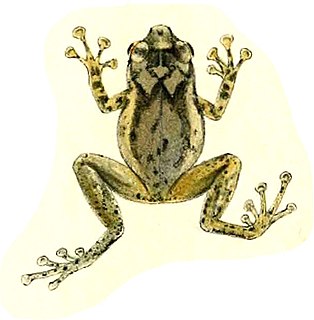
Astylosternus batesi is a species of frog in the family Arthroleptidae. It is found in Cameroon south of Sanaga River, Equatorial Guinea, Gabon, southwestern Central African Republic, the Republic of the Congo, and the extreme western Democratic Republic of the Congo (Mayombe). The specific name batesi honours George Latimer Bates, an American naturalist. However, its vernacular name is Benito River night frog, apparently in reference to its type locality, Benito River in Equatorial Guinea.

Scotobleps is a monotypic frog genus in the family Arthroleptidae; its sole species is Scotobleps gabonicus, sometimes known as the Gaboon forest frog. It is found in eastern Nigeria, western Democratic Republic of the Congo, western and southwestern Cameroon, Equatorial Guinea, and western Gabon. It is also presumed to occur in the western Republic of the Congo and in the Cabinda Enclave of Angola.

Dryaderces inframaculata is a species of frog in the family Hylidae. It is endemic to Brazil and known from between the Tapajós and Xingu Rivers in Pará. Until recently, it was only known from one specimen collected near Santarém, probably around 1876, by Henry Wickham. Common name Santarem treefrog has been coined for it.

Alexteroon hypsiphonus is a species of frog in the family Hyperoliidae. It is found in southern Cameroon, Gabon, Equatorial Guinea, the western Republic of the Congo, and northwestern Angola. Common name cross-banded egg-guarding frog has been proposed for it.

Hyperolius jynx is a species of frog in the family Hyperoliidae. It is endemic to the Rumpi Hills in south-western Cameroon. The common name smooth egg-guarding frog has been proposed for this species.
Pristimantis vertebralis is a species of frog in the family Craugastoridae. It is endemic to the Andes of Ecuador and occurs in the Carchi, Imbabura, Pichincha, Cotopaxi, Bolívar, and Azuay provinces. Common name vertebral robber frog has been coined for it.

The desert rain frog, web-footed rain frog, or Boulenger's short-headed frog is a species of frog in the family Brevicipitidae. It is found in Namibia and South Africa. Its natural habitat is the narrow strip of sandy shores between the sea and the sand dunes. It is threatened by habitat loss by such factors as mining and tourism.

Oreophryne celebensis is a species of frog in the family Microhylidae. It is endemic to northern Sulawesi, Indonesia. Common name Celebes cross frog has been coined for it.

Petropedetes johnstoni is a species of frog in the family Petropedetidae. It is endemic to coastal Cameroon and known with certainty only from few localities. For a period, Petropedetes newtonii was considered a junior synonym of this species, leading to a much broader distribution. The two species are now considered distinct, but information on Petropedetes johnstonisensu stricto is limited. Common name Johnston's water frog has been coined for this species.
Phrynobatrachus ogoensis is a species of frog in the family Phrynobatrachidae. It is endemic to Gabon and is known from its type locality, Lambaréné in the Moyen-Ogooué Province, and from the Ramba Village in the Ogooué-Ivindo Province, in the buffer zone of the Lopé National Park.
Meristogenys macrophthalmus is a species of frog in the family Ranidae. It is endemic to Sarawak in northern Borneo (Malaysia) and is only known from its type locality in the Bintulu District. The specific name macrophthalmus is derived from the Greek words macros (="large") and ophthalmos (="eye") and refers to the large eyes of this frog. Common names Matsui's Borneo frog, large-eyed torrent frog, and big-eyed torrent frog have been coined for it.

Cornufer macrops, also known as the Aresi wrinkled gound frog, is a species of frog in the family Ceratobatrachidae. The specific name macrops refers to the very large eyes of this species. It is endemic to Bougainville Island, in the Papua New Guinean part of the Solomon Islands archipelago. It is only known from the mountains of northern Bougainville Island, near Kunua, although its true range could be much wider.

Humerana oatesii is a species of frog in the family Ranidae. It is endemic to Burma. This species is only known from type series collected from "near Toungoo" in the Pegu Range. The specific name oatesii honours Eugene W. Oates, English civil servant and naturalist who collected the type series. However, the common name Toungoo frog has been proposed for it.
Odorrana supranarina is a species of frog in the family Ranidae. It is endemic to Ryukyu Archipelago, Japan, and is known from the islands of Ishigaki and Iriomote, both in the Yaeyama Group. The specific name supranarina refers to the large size of this species —at the time of the species description, it was the largest member of the so-called Rana narina complex. Common name greater tip-nosed frog has been coined for it.

Raorchestes parvulus is a species of frog in the family Rhacophoridae. It is found from eastern Bangladesh east through Myanmar and Thailand to Cambodia, northern Vietnam, Laos, and Peninsular Malaysia. Its distribution might well extend into northeastern India and southern China. This species was first described by George Albert Boulenger based on seven specimens collected by Leonardo Fea from Karen Hills, Burma.
Chalcorana labialis, also known as the white-lipped frog, is a species of "true frog" in the family Ranidae. As currently known, it is endemic to Peninsular Malaysia, although it might also occur in Singapore. Molecular data suggest presence of three distinct lineages in the same area, one of which is not closely related to Chalcorana labialis and which could represent an unnamed species.
Chalcorana chalconota is a species of "true frog", family Ranidae. It is endemic to Indonesia and occurs in southern Sumatra, Java, Bali, and a few smaller islands. Populations previously assigned to this species now belong to a number of other Chalcorana species, leading to the current delineation of Chalcorana chalconota with a much narrower range. This species is also known as the Schlegel's frog, brown stream frog, copper-cheeked frog, or, among with many other species, white-lipped frog.

Chalcorana eschatia is a species of "true frog" in the family Ranidae. It is known from southern Thailand, but is likely to be more widespread. It was split off from Chalcorana chalconota by Robert Inger and colleagues in 2009, along with a number of other species in so-called "Rana chalconota group". The specific name eschatia, derived from the Greek word for "outskirt", refers to distribution of this species being at the edge of the geographical range of the group.
Chalcorana parvaccola is a species of "true frog" in the family Ranidae. It is endemic to Sumatra, Indonesia. It was split off from Chalcorana chalconota by Robert Inger and colleagues in 2009, along with a number of other species. The specific name parvaccola is derived from Latin parvus meaning small and accola meaning neighbor, and refers to this species being smaller than its "neighbor", the related Sumatran species Chalcorana rufipes.
Chalcorana rufipes is a species of "true frog" in the family Ranidae. It is endemic to Sumatra, Indonesia. It was split off from Chalcorana chalconota by Robert Inger and colleagues in 2009, along with a number of other species. The specific name rufipes is derived from Latin rufus meaning reddish and pes meaning foot, in reference to the reddish tinge on the underside of the pedal webbing in life.













